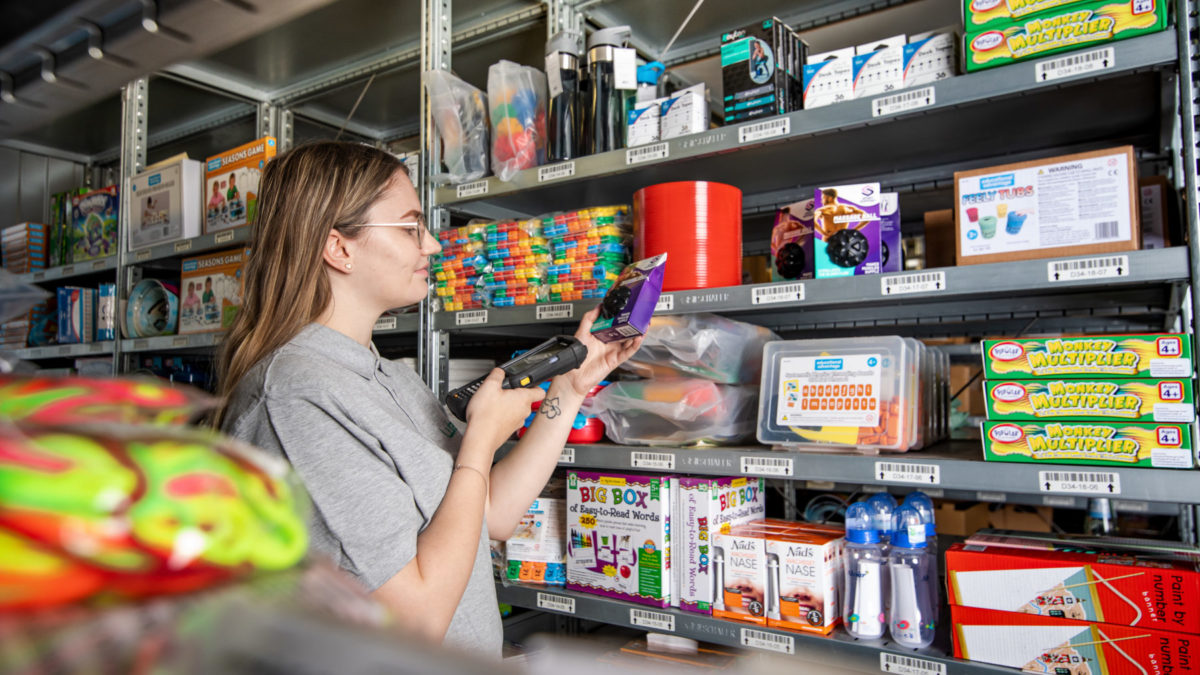sales@lufapak.de +49 2631/384-0 Contactform
What is the “First in First out” principle?
FIFO is the English abbreviation for “first in, first out”. This means that the first item that is put into storage is also the first item that is taken out and is therefore available for shipping. This is usually achieved by placing loading equipment (trays or bins) on the shelf from one side and removing them from the other. FIFO is used whenever the time factor plays an important role in storage. This is relevant when stored goods do not have an expiration date (for example, dairy products) or lose value over time (for example, rusted spare parts in the automotive industry).
Suppose you want to store yogurt. Since it is perishable, it is important that freshly stored products leave the warehouse as soon as possible. Items that are put away first leave the warehouse first, which prevents spoilage of individual items that are left too long. In inventory management, FIFO is the usual procedure. This is because, if possible, the oldest stock (the one that was put away first) should also be used up first. In the storage of bulk goods, the FIFO principle is usually fulfilled by silos. Products with an expiration or use-by date are typically removed from storage using the FEFO (First Expired – First Out) method.
Where is FIFO used?
The FIFO approach makes more sense in some industries than others. For example, in the case of perishable goods, it is important that they no longer need to be stored. Food, animal and plant raw materials or pharmaceuticals fall under the category of perishable goods. Another area is bulk goods, which can stick together over time. Here, the FIFO approach is applied via silos. In addition, weather effects are also a reason for the FIFO process. Metal that rusts over time should be replaced regularly. Many companies try to adopt the FIFO method because old products should not stay in the warehouse for a long time and all products are continuously run and replaced again and again. In this process, the product with the longest shelf life is selected first.
Especially the food industry relies on this method because it has a best before date. In order to run a FIFO process, the warehouse must be set up accordingly.
What are the advantages of the first in first out principle?
The first in first out principle offers numerous advantages. One is its consistent storage period. When the first items in storage are moved out of the warehouse for the first time, they will always spend approximately the same amount of time in the warehouse at the same throughput. This allows you to keep your inventory up to date. Using the FIFO method can minimize loss of value due to aging, damage and rust. Another benefit is traceability in case of potential problems. If your warehouse is connected to a production environment, using this storage principle can improve the traceability of any issues that arise. This is made possible by the fact that there is a predefined order in which goods are processed.

FIFO racks allow you to connect different work areas in your warehouse. For example, if an item is placed on a shelf facing the storage area, the item is picked up again on the side facing the picking area. To use FIFO, the shelves must be accessible from both sides. Therefore, the warehouse layout should be designed with aisles on both sides of the shelves. This is a major potential disadvantage of this method, as it can lead to a loss of storage capacity.
How is the calculation done in the first in first out principle?
The inventory is valued according to the FIFO method, using the purchase price from the batch in stock in the shortest possible time. The last price is used to calculate the valued inventory and is added up until the current inventory is reached. Note that depending on the valuation method chosen, there may be differences in the valuation of inventory and material consumption, especially if the purchase price fluctuates.
What is the LIFO principle?
In the FIFO principle, the goods that are put away first are also taken out first, while in the LIFO principle, the goods that are put away last are taken out first. The abbreviation LIFO stands for “last in first out”. When this principle is applied, pallets are stored and retrieved on the same side of the rack. The use of this storage and retrieval method is always worthwhile if exclusive access to the last pallet stored does not negatively affect the company balance sheet. This is usually possible when storing homogeneous goods without expiration dates. Suppose you want to store building materials such as ceramics, glass or stone. These are products that have no expiration date or lose value over time. Therefore, it does not matter which of the stored pallets for a particular type of product leaves the warehouse first.
First in first out warehouse as opposed to LIFO
The choice between FIFO and LIFO is one of the basic decisions in warehouse design and organization. It is important to establish storage principles that are consistent with your planned operations. In most cases, it is recommended to use the FIFO principle when the shelf life of an individual item is a critical consideration due to expiration dates or potential loss of value. However, if this is not the case, you can prioritize the LIFO principle as it saves space or costs. Depending on the size of the warehouse, both storage principles can be used in parallel. All you need to do is place different types of racks in different areas of the warehouse. LIFO or FIFO racking can also be combined with traditional pallet racking to provide direct access to all items of a particular item type. If you need help in planning and implementing your warehouse, feel free to contact us. Our experts will find the best solution for your individual project.
Choosing between FIFO and LIFO is one of the fundamental decisions when planning and organizing a warehouse. It is important to choose storage principles that are consistent with your planned operations. If the storage time of an individual shipment is critical due to its expiration date or potential loss of value, it is recommended in most cases to use the FIFO principle. However, if this is not the case, the LIFO principle may be preferred for space or cost reasons. Depending on the size of the warehouse, both storage principles can also be used in parallel. All you need to do is to place different types of racks in different areas of the warehouse. It is also possible to combine LIFO or FIFO racks with conventional pallet racks to provide direct access to all items of a certain item type.
Contact us now and get advice


